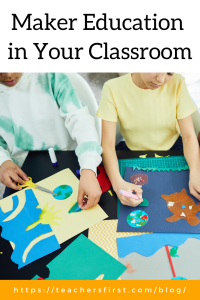What is maker education? In maker education, “students imagine, design, and create projects that align the content of learning with hands-on application” (Makered.org). Maker education was born from the maker movement, which believes that we are all “makers” and can be creators—not just consumers—of things. Makerspaces are specific spaces in schools, libraries, and community organizations that contain tools and materials people can use to make collaboratively or alone. Maker Education promotes critical thinking, problem solving, collaboration, persistence, and social-emotional competencies! Check out maker stories at Why I Make.
So, where do you start? Many familiar education information sites like Edutopia, Education Week, and KQED have maker education information sections. There are also many maker-centered sites like MakerEd, SparkFun, and Makerspaces.com that feature information to help you get started. Maker education can be used in any area of the curriculum and in any subject. Making can be incorporated into English, math, social studies, science, literacy, and even the library!
Design thinking and design challenges can be an easy and fun entry into the world of making. Start off with easy design challenges that can be done in person, online, or a combination of the two. Once your class has an understanding of design challenges, you can work up to larger scale challenges like the LEGO Build the Change challenge for younger students or the Make Justice: High School “Make It Real” Design Slam for older students (both challenges can be modified for different age groups). There are many ways to foster the maker in your students. Once you have decided that this maker journey is for you, explore maker lessons and projects to expand your maker repertoire and review maker classroom management. You may even decide to create a mini makerspace in your classroom!
Choose to start your maker education journey today and your students will reap the benefits! As always, check out TeachersFirst resources and blog posts on this subject for more information. Happy making!


